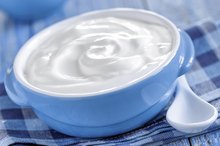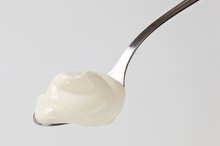Side Effects of Probiotics on Children
Probiotics are live and active microorganisms, mainly bacteria, which are similar to those that exist naturally in the human digestive tract. Often referred to as friendly bacteria, probiotics may help to encourage digestion and regularity, as well as replenish bacterial flora after a course of antibiotics. Side effects of probiotics in children are similar to those in adults, although they may be more dangerous in children. You should always consult your child’s pediatrician before feeding them food containing probiotics.
Infection
Due to the growing evidence that probiotics may be beneficial to adults, many food products for children are probiotic. Children may benefit from probiotics, as they may help to treat common childhood conditions such as respiratory infections, food allergies and eczema, although further research is warranted, according to Consumer Reports. Nonetheless, infection is a dangerous side effect in children, including infants and toddlers, should they have a suppressed or weakened immune system due to an underlying condition. If your child has short bowel syndrome, certain lactobacilli can cause infection as well. Probiotic sources for children include yogurt, yogurt shakes and fortified foods.
- Due to the growing evidence that probiotics may be beneficial to adults, many food products for children are probiotic.
- Children may benefit from probiotics, as they may help to treat common childhood conditions such as respiratory infections, food allergies and eczema, although further research is warranted, according to Consumer Reports.
Intestinal Gas
Probiotic Dosage After Antibiotics
Learn More
Intestinal gas is the most common side effect of probiotic use in both children and adults. This is due to the gas-producing bacteria present, such as lactobacilli and bifidobacteria, which break down lactic acid. Most cases of intestinal gas are mild and only require reducing the amount of probiotics. If gas becomes exceedingly painful or accompanies any other symptoms, such as watery stool or diarrhea, you should contact a physician. This may indicate an underlying gastrointestinal problem in your child that could be dangerous.
- Intestinal gas is the most common side effect of probiotic use in both children and adults.
- Most cases of intestinal gas are mild and only require reducing the amount of probiotics.
Bloating
Like intestinal gas, bloating often appears as a common side effect in children, although it is generally quite mild. Bloating too is a result of gas buildup within the intestines and stomach and can become severe and painful in children with compromised immune systems. It is therefore exceedingly important to speak to your doctor before offering your child any probiotic-containing food, even if it is generally recognized as safe.
Related Articles
References
- The American Academy of Pediatrics: Probiotics in Formulas
- National Center for Complementary and Alternative Medicine: Introduction to Probiotics
- National Center for Complementary and Integrative Health. Probiotics: What you need to know. Updated August 2019.
- Su G, Ko C, Bercik, P, ET al. AGA clinical practice guidelines on the role of probiotics in the management of gastrointestinal disorders. Gastroenterology. June 9 2020. doi:10.1053/j.gastro.2020.05.059
- Didari T, Mozaffari S, Nikfar S, Abdollahi M. Effectiveness of probiotics in irritable bowel syndrome: Updated systematic review with meta-analysis. World J Gastroenterol. 2015;21(10):3072-3084. doi:10.3748/wjg.v21.i10.3072
- Homayouni A, Bastani P, Somayeh Z, et al. Effects of probiotics on the recurrence of bacterial vaginosis: A review. Low Genit Tract Dis. 2014 Jan;18(1):79-86. doi:10.1097/LGT.0b013e31829156ec
- Falagas ME, Betsi GI, Athanasiou S. Probiotics for prevention of recurrent vulvovaginal candidiasis: a review. J Antimicrob Chemother. 2006;58(2):266-72. doi:10.1093/jac/dkl246
- Floch MH, Walker WA, Madsen K, et al. Recommendations for probiotic use-2011 update. J Clin Gastroenterol. 2011;45 Suppl:S168-71. doi:10.1097/MCG.0b013e318230928b
- Doherty G, Bennett G, Patil S, Cheifetz A, Moss AC. Interventions for prevention of post-operative recurrence of Crohn's disease. Cochrane Database Syst Rev. 2009;(4):CD006873.doi:10.1002/14651858.CD006873.pub2
- National Institutes of Health Office of Dietary Supplements. Probiotics. Updated une 26, 2019.
- Cai, J.; Zhao, C.; Du, Y. et al. Comparative efficacy and tolerability of probiotics for antibiotic-associated diarrhea: Systematic review with network meta-analysis. United European Gastroenterol J. 2018 Mar; 6(2): 169-80. DOI: 10.1177/2050640617736987.
Writer Bio
Skyler White is an avid writer and anthropologist who has written for numerous publications. As a writing professional since 2005, White's areas of interests include lifestyle, business, medicine, forensics, animals and green living. She has a Bachelor of Arts in anthropology from San Francisco State University and a Master of Science in forensic science from Pace University.









